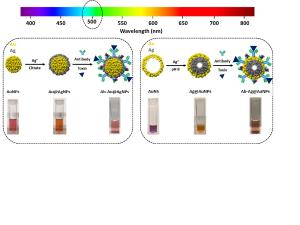ACS Applied Materials & Interfaces Naked-eye detection of biotoxin using gold-silver core-shell nanoparticles

Our work "Core−Shell Gold/Silver Nanoparticles for Localized Surface Plasmon Resonance-Based Naked-Eye Toxin Biosensing" by Alexis, Lu, David, Yacine, Raphael, Michèle, Bo & Souhir, is now published in ACS AMI
link: https://doi.org/10.1021/acsami.9b14980
Abstract: The Localized Surface Plasmon Resonance (LSPR) phenomenon provides a versatile property for biodetection. Herein, this unique feature was employed to build up a homogeneous optical biosensor to detect staphylococcal enterotoxin A (SEA) in solution down to very low levels by naked‑eye readout. If the initial position of the LSPR band is located in the cyan region, even a small red shift (~2‑3 nm) induced by Refractive index (RI) change close to the surface of nanoparticles (NPs), could make the light absorption transit from cyan to green and become visually detectable via a concomitant change in the complementary colors. In this work, we aimed at synthesizing two types of NPs based on compositionally complex core‑shell NPs - Ag shell on AuNPs (Au@AgNPs) and Ag inside gold nanoshell (Ag@AuNPs). By controlling the thickness of the shells as well as their surface chemistry with anti-SEA antibody, the LSPR band was tuned to near 495 and 520 nm, for Ag@AuNPs and Au@AgNPs, respectively. The two particle systems were subsequently applied as transducers to spectroscopically and visually detect anti-SEA antibody - SEA interactions. Upon addition of SEA large red-shifts of the LSPR band were observed spectroscopically and the limits of detection (LOD) were estimated to 0.2 nM and 0.4 nM for the Au@AgNPs and Ag@AuNPs, respectively. Although the two sets of NPs gave almost identical LOD, the Ag@AuNPs whose initial position of the LSPR band was tuned in the cyan to green region (~500 nm) displayed a substantially more distinct color change from orange to red, as revealed by the by naked‑eye. We foresee significant potential to this strategy in medical diagnostic and environmental monitoring, especially when basic laboratory infrastructure is sparse or non-existent
Also in the section
- Cover in ACS Sensors
- Cover Biosensors
- Article in Nanomaterials
- AuNRs
- Anis arrival
- OrNano-YouTube
- Review in Biosensors & Bioelectronics
- Webinar SCT
- Insplorion - User Meeting
- JSE 2020 - French Electron Spectroscopy Workshop
- Sunny
- Mona arrival
- CNano-SFNano Joint Congress 2019 - Dijon
- Mederic Thesis Defense
- Article in Talanta
- Article in Nanoscale Advanced
- Cover for ACS Appl. Nano Mater.
- Nice gathering
- Alexis is leaving !
- Bruno and Raphael defense
- Souhir : Invited Lecture
- Article in biosensors
- Yacine Mazouzi, price
- BioSurf 2019
- Atul Parikh
- Cover for J Phys Chem C
- Mathieu Nicolas has joined us
- Bruno & Raphael
- Insplorion
- Ceremony for Master diploma
- Lu : PhD defense
- Fadoua's arrival
- Photoniques
- Daoming arrival
- Mathieu's paper in Journal of the Optical Society of America
- Somia Tomane - Thesis Defense
- Walid's arrival
- Valentin's arrival
- David Hu - Thesis defense
- Vincent Pellas - Thesis Defense
- Paper in ACS ANM
- Paper in ACS Sensors
- Yacine Mazouzi Thesis defense
- Issue-cover selected
- Review in Antibiotics
- IEEE Sensors Council France
- IEEE Sensors
- ACS Sensors
- Sara Martinez Concheso
- PhD defense Mathieu Nicolas
- PEP21 school

